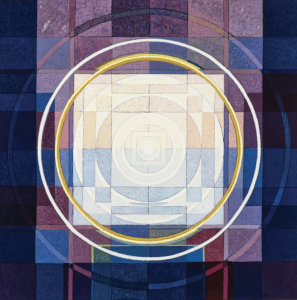
John Clemmer, Topgraphia IV-Cosmos II, 1971, Oil on canvas, New Orleans Museum of Art, Gift of Jonathan C. Clemmer, 97.823 © 3618 Studio, LLC
Deceptive Space: Op Artfrom the New Orleans Museum of Art, on view at the Slidell Cultural Center March 18 – April 29, explores geometric abstraction and optical illusion through a selection of rarely-seen works from NOMA’s permanent collection. The exhibition considers Louisiana artists within the broader discourse of the international Op Art movement and its influence.
For centuries, most visual art featured elements of illusion. The first illusion was one of content — the work of art figuratively depicting a person or a scene but not a literal representation. Another illusion was one of dimension. The development of linear perspective, attributed to the Italian Renaissance architect Filippo Brunelleschi in 1415, created a highly realistic depiction of depth on a flat surface. From the ancient Greeks on, artists employed trompe l’oeil, translating as “deceive the eye,” rendering an element with such veracity that the viewer questions its material reality. In the late 19th century, techniques such as the post-Impressionist Georges-Pierre Seurat’s pointillism were developed to further fool the eye as distinct dots of color were closely arranged in patterns to create an image. However, it wasn’t until the 1950s that the illusion itself became the artistic focus.
Stripped of content and conceptual association, optical or retinal art explores illusion and perception through the careful manipulation of color and shape. Influenced by the geometric abstraction of the Constructivists, graphic design, developments in technology and materials, optical artists of the 1960s and ‘70s were concerned with what was depicted and how the eye and the brain perceived it. In 1965, the Museum of Modern Art organized the seminal exhibition The Responsive Eye, which looked beyond “tendency, group, or country” to consider the recurrent themes seen in the work of artists from fifteen countries, focusing on perceptual abstraction and perceptual movement.
Deceptive Space will showcase works by pivotal Op artists Victor Vasarely, Bridget Riley, Francis Celentano, and Arnold Schmidt, who were featured in The Responsive Eye, with the addition of work by renowned Louisiana artists Robert Gordy, John Clemmer, and Kendall Shaw. Immaculate precision and rigorous mathematics are the foundations that define these illusory spaces. Space appears to either fold in on itself or protrude out in Vasarely, Riley, and Clemmer’s work, an effect created purely through the juxtaposition of geometric shapes and shaded hues. The viewer’s eye is challenged by bright, contrasting colors of works by Celentano, Schmidt, and Shaw. The canvas appears to undulate under inspection. Though each artist had a unique approach and style, all were concerned with reality and perception, what was visible and how it was read, the physiological and psychological.
The Slidell Cultural Center is located at 2055 Second Street in Slidell, Louisiana. For more information, call 985.646.4375
— Anne C. B. Roberts, Curatorial Assistant